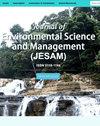Phytoremediation Potential of Vetiver Grass (Chrysopogon sp.) System for Improving the Water Quality of Aquaculture Ponds along the Marilao and Meycauayan River in Bulacan, Philippines
IF 0.3
4区 环境科学与生态学
Q4 ENVIRONMENTAL SCIENCES
Journal of Environmental Science and Management
Pub Date : 2020-07-16
DOI:10.47125/jesam/2019_sp1/03
引用次数: 1
Abstract
The Marilao and Meycauayan Rivers are known to be polluted with heavy metals and organic matter due to different anthropogenic and industrial activities along the river system. Many aquaculture ponds are situated along the river system and obtain water from the river. In order to address this problem, phytoremediation or the use of plants was tested as a low-cost remediation system to reduce the pollution on the ponds. The vetiver grass was utilized because of its unique features and its ability to accumulate heavy metals. A vetiver pontoon was established on fishponds located at Brgy. Nagbalon, Marilao and Brgy. Liputan, Meycauayan. The vetiver roots and leaves were analyzed for heavy metal content. There is an accumulation of toxic heavy metals such as lead, chromium, manganese and copper in the roots and leaves. Manganese had the highest accumulated metal by the vetiver grass. It was observed that there is a significant difference of heavy metal absorption of Pb, Zn, Mn and Cr through time. The vetiver grass favored accumulating heavy metals in the roots based on the translocation factor (TF). Vetiver grass can potentially improve some water quality parameters such as lowering levels of ammonia, BOD and COD and absorb heavy metals such as Pb, Zn, Mn and Cr which are harmful to fish. The vetiver grass is a low-cost phytoremediation technology with a high potential impact in cleaning up the water in ponds.香根草(Chrysopogon sp.)系统对菲律宾布拉坎Marilao河和Meycuayan河沿岸养殖池塘水质的植物修复潜力
众所周知,由于沿河流系统的各种人为和工业活动,马里劳河和梅卡延河受到重金属和有机物的污染。许多水产养殖场位于河流水系沿岸,从河流取水。为了解决这一问题,植物修复或利用植物作为一种低成本的修复系统来减少对池塘的污染。香根草因其独特的特性和积累重金属的能力而被利用。在Brgy的鱼塘上建立了香根草浮桥。Nagbalon, Marilao和Brgy。Liputan Meycauayan。对香根草根和叶进行重金属含量分析。有毒重金属如铅、铬、锰和铜在根和叶中积累。香根草积累的金属中锰含量最高。观察到不同时间对Pb、Zn、Mn、Cr的重金属吸收量有显著差异。基于转运因子(TF),香根草有利于重金属在根系的积累。香根草可以改善水质参数,如降低氨、BOD和COD水平,吸收对鱼类有害的Pb、Zn、Mn和Cr等重金属。香根草是一种低成本的植物修复技术,在净化池塘水体方面具有很高的潜力。
本文章由计算机程序翻译,如有差异,请以英文原文为准。
求助全文
约1分钟内获得全文
求助全文
来源期刊

Journal of Environmental Science and Management
ENVIRONMENTAL SCIENCES-
CiteScore
0.90
自引率
0.00%
发文量
10
审稿时长
2 months
期刊介绍:
The Journal of Environmental Science and Management (JESAM) is an international scientific journal produced semi-annually by the University of the Philippines Los Baños (UPLB).
JESAM gives particular premium to manuscript submissions that employ integrated methods resulting to analyses that provide new insights in environmental science, particularly in the areas of:
environmental planning and management;
protected areas development, planning, and management;
community-based resources management;
environmental chemistry and toxicology;
environmental restoration;
social theory and environment; and
environmental security and management.
 求助内容:
求助内容: 应助结果提醒方式:
应助结果提醒方式:


